 |
|
|---|---|
| CP Foundation | About CP Biennale | 2003 | 2005 | Contact Us | |
         
|
|
|
Kota Budi Lim & Associates Chartered Architect & Urban Designer was established in 1985 by Budi Lim. Among the urban designs carried out by this firm are: the revitalization of Kali Besar, Jakarta Kota; urban landscape improvement in Jl. Pintu Kecil, Roa Malaka, Jl. Mangga Dua, Jl. Orpa and surroundings; improvement of landscape along Jl. Thamrin dan Sudirman. The active members of Budi Lim & Associates involved in the work done for CP Biennale 2005 are: Budi Lim, Deny Sukandar, Hendro Wahyu Prakosa, Arman Kumala, and Ade Dewi H. Abidin. The creation of this work was supported by the office of Budi Lim & Associates. From a historical perspective, it is clear that Kota Tua (Old City) has had a major influence on trade and culture, not only in Asia, but also worldwide. The wheels of the national economy first began turning in this area, and their movement is actively felt even today. In relation to spatial planning, the historical area of Kota Tua has the unity of function and anatomy characteristic of an ideal urban environment. It has a gateway (Sunda Kelapa Port), institutional center (Fatahilah), trade center (Kali Besar), and a central regional transportation center (Kota Station). These centers are supported by a variety of areas and facilities, which form layers of community life in Kota Tua. The richness and uniqueness of the character of Kota Tua area make it an invaluable asset. Based in the conviction that the preservation of this uniqueness is imperative, a revitalization process should be undertaken. However, any steps toward renewal in this area must involve much more than cosmetic or aesthetic efforts, and focus more on the process of reviving and healing the spirit, as well as enhancing the value, of the area. It is important that any revitalization support the revival of the economic, social, cultural activities that are the measure of the health of any area. Jakarta Kota Tua is a segment of concrete historical facts that cannot be manipulated. It is necessary to analyze the role of Kota over time. This analysis must be down through a macro approach encompassing the entire Kota area, as well as a micro approach toward the various components that make up its physical presence (blocks, streets, and structures) and also its non-physical presence (function, activity, and culture). Further, the choices that exist must be thoroughly explored: conservation, revitalization, or transformation. All of these alternatives, basically, should be considered within the context of renewing Kota Tua with preservation of its heritage in mind. It is important for us all to determine the first steps to be taken in this process. The outer space (outdoors) is an effective media for reweaving the components of city space into a unified whole. Further elaboration should then be done with emphasis on the upgrading of the quality of this external space, as well as its optimal function in clarifying the role of Kota Tua. (Artist's Statement)
|
|
|
CP foundation | About CP Biennale | 2005 Biennale | 2003 Biennale | Contact Us
Jl. Suryopranoto 67A, Jakarta 10160, Indonesia. ph. +62.21.3448126, 3853206 | fax. +62.21.3853203, 3853208 info@cp-foundation.org |

